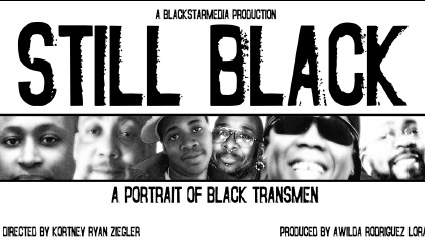This is the first installment in my series of 'Resource Spotlights' wherein I'll review a media text or article in terms of its pedagogical application for teaching on gender in keeping with the framework that I generally use for doing so.
--
INFO...
STILL BLACK: A portrait of black transmen
Dir. Kortney Ryan Ziegler. Prod. Awilda Rodriguez Lora
(C) Blackstar Media, 2009. B+W film.
PREAMBLE...
Let's say for the sake of argument that, contrary to the stance that I usually take on such things, I decided to teach with a film on trans lives as part of a course on identity politics for teacher education students. How could I do this in such a way that would invite a broader engagement with the issues than is usually the case when such 'trans' is brought up in this context? Can it be done without peddling trans as spectacle, on the one hand or, on the other, tacitly allowing students to distance themselves from their own complicity in gender-normativity by focussing on 'the Others' of sex and gender? I didn't used to think so, until I saw STILL BLACK.
From the website: STILL BLACK "is an alternative feature-length documentary that explores the lives of six black transgender men living in the United States. Through the intimate stories of their lives as artists, students, husbands, fathers, lawyers, and teachers, the film offers viewers a complex and multi-faceted image of race, sexuality and trans identity."
GREAT FOR...
The power of this film is in its quotidian representation of the ups and downs of living life. The lives lived happen to be those of black men who are trans or trans men who are black or men who are trans and black, etc. To the very limited extent that these men can be cast as a group, there is more within-group disparity among their wildly different self-representations, discourses and identities (as they express them) than there would be between one of these men and any audience member. However, one of the (very few) recurring themes across their accounts is coming to terms with their experiences of the devastating systemic racism habitually levied at black men in America. In the end, therefore, although the interviewees' narratives all make frequent reference to their individually embodied histories of gender, the pedagogical application that I foresee is the film's power to convey an understanding of racism that is uniquely powerful, perhaps even moreso if students are actively discouraged from dwelling on the 'trans-ness' of these lives in responding to/discussing the film.
For example, the film could be selectively screened by an instructor in order to foreground testimony related to racism, or the accounts in which racism is centrally addressed. A guided debrief activity could consist of students being required to discuss the film more broadly followed by an interrogation of their (if applicable - likely so, in my estimation/experience) focus on the 'trans-ness' of the excerpts and the two-fold implications of this focus: their avoidance of racism, and the politics of the trans-ness focus in line with what I have discussed before.
DRAWBACKS...
The drawbacks of using this film in teacher education (or any other kind of education) centre on racism as well, but of a different sort. Some of the interviewees espouse a point of view that is undeniably sexist and chauvinistic vis a vis their female partners or women in general. Although this discourse is certainly not endemic to the film as a whole, this portrayal of black masculinity will feel comfortable for a white or otherwise non-black audience insofar as this is the habitual racist representation thereof offered by mainstream white media. Challenging students' racism that leads to this comfort would be absolutely paramount in any pedagogical use of the film in order for the screening to be an anti-racist space.
BOTTOM LINE...
This is an excellent pedagogical tool - however, I would strongly discourage the film's use by instructor who does not have experience with anti-racist education and/or facilitation with white people and (if applicable) mixed groups.
genderism n. the pervasive and systemic belief in male/masculine and female/feminine as the only true, natural and correct gender identities and expressions
gender normativity n. the privileged state lived - whether momentarily or perpetually - by those whose genders perceptibly 'fit' with locally-derived and understood expressions of masculinity (for men) and femininity (for women)
gender non-normativity n. the oppressed state lived - whether momentarily or perpetually - by those whose genders do not perceptibly fit, as above
Wednesday, March 25, 2009
Resource Spotlight - STILL BLACK: A portrait of black transmen
Labels:
film,
pedagogy,
race and racism,
resource spotlight,
transgender
Subscribe to:
Post Comments (Atom)

.bmp)




No comments:
Post a Comment